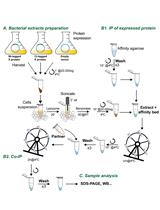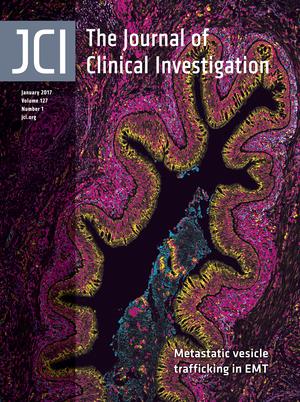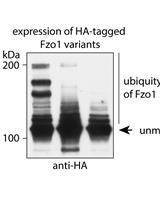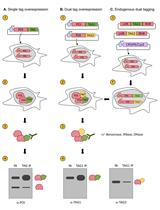- EN - English
- CN - 中文
Assessment of Modulation of Protein Stability Using Pulse-chase Method
使用脉冲追踪法评估蛋白质稳定性的调节
发布: 2017年08月20日第7卷第16期 DOI: 10.21769/BioProtoc.2443 浏览次数: 11785
评审: Jia LiMohan TCAnonymous reviewer(s)

相关实验方案

蛋白质pull-down免疫共沉淀实验分析病毒DNA结合蛋白质之间的直接相互作用
Ana Lechuga [...] Modesto Redrejo-Rodríguez
2018年01月05日 11838 阅读
Abstract
Pulse-chase technique is a method widely used to assess protein or mRNA stability. The principle of pulse-chase relies on labeling proteins or mRNA produced during a short period of time called ‘pulse’ and then following the rate of disappearance of those labeled proteins over a period of time called ‘chase’. This technique thus allows quantitative analysis of modulation of protein or mRNA stability under different treatments or culturing conditions.
Keywords: Pulse-chase (脉冲追踪)Background
Pulse-chase technique is a method that involves culturing cells in a medium containing labeled amino acids for a short period of time known as ‘pulse’. This results in the generation of newly-synthesized polypeptides incorporating labeled amino acids. The pulse step is followed by a ‘chase’ step in which labeling medium is washed out to terminate the labeling process and is replaced by a medium with non-labeled amino acids to allow for the quantification of the initially synthesized radiolabeled proteins at any given time during this chase phase. This technique thus allows quantitative analysis of the processing of a protein of interest from synthesis to degradation in a timely fashion. Pulse-chase method can be used to analyze a variety of processes such as protein folding, co-translational modifications and intracellular transport (Jansens and Braakman 2003; Magadán, 2014). However, pulse-chase technique is most commonly used to assess the stability of a protein under different experimental conditions.
Radioactivity is a commonly used label. Labeling is usually done for proteins using radioactive S35 Methionine. The kinetics of disappearance of the radiolabeled proteins relies on how fast these proteins get degraded which can be exploited to examine the effect of different experimental conditions on protein stability. To assess the stability of a particular protein of interest, this protein is immunoprecipitated from all other immunolabeled proteins that were produced during the pulse period using a specific antibody. Immunoprecipitation will isolate a ratio of radiolabeled protein that was produced during the pulse and has not been degraded until the time of immunoprecipitation. Then radioactivity is measured to assess the relative amounts of labeled protein over a period of time.
While the focus of this protocol is the assessment of protein stability, pulse-chase method can also be used to assess the stability of mRNA. Labeling of mRNA during the pulse step can be done using 3UTP. Quantitative analysis of mRNA of interest then follows by taking aliquots of total mRNA at different time points and applying one of two methods: 1) Dot blot method in which the labeled mRNA of interest anneals to a complementary single stranded nucleic acid attached to a filter paper, other labeled mRNA are then washed out and radioactivity is measured by autoradiogram or scintillation counting, 2) Affinity purification method in which the labeled mRNA of interest anneals to a complementary anchored RNA/DNA immobilized to beads, the beads are then collected by centrifugation and radioactivity of the captured labeled mRNA is quantified.
Materials and Reagents
Other than the materials routinely used for mainlining cells in tissue culture and for immunoprecipitation and SDS-PAGE, the specific reagents required for the pulse-chase experiment are:
- Pipette tips
- 1.5 ml micro-centrifuge tubes
- Cell culture dishes
- Plastic cell scraper
- Tissue culture medium, appropriate for the cell line used, without methionine and cysteine
- DPBS
- Dithiothreitol (DTT)
- Protease inhibitor cocktail
- Phosphatase inhibitor cocktail (Sigma-Aldrich, catalog number: P2850 )
- N-Ethylmaleimide (NEM) (Sigma-Aldrich, catalog number: R3876 )
Note: This product has been discontinued. - Bradford colorimetric assay
- Protein A-Sepharose bead
- [35S]-Methionine (PerkinElmer, catalog number: NEG709A500UC )
- Methionine (250 mM in H2O, store at -20 °C) (Sigma-Aldrich, catalog number: M5308 )
- Cysteine (500 mM in H2O, store at -20 °C) (Sigma-Aldrich, catalog number: C7352 )
- Sodium chloride (NaCl)
- Triton X-100
- Ethylenediaminetetraacetic acid (EDTA)
- Glycerol
- Tris-HCl
- Sodium dodecyl sulfate (SDS)
- Methanol
- Acetic acid
- Pulse (labeling) medium (see Recipes)
- Chase medium (see Recipes)
- Lysis buffer (see Recipes)
- Wash buffer (see Recipes)
- Fixation solution (see Recipes)
Equipment
- Pipettes
- Refrigerated centrifuge
- 95 °C heat block
- Cell culture incubator (37 °C humidified 5% CO2)
- SDS-PAGE apparatus
- Radiographic cassette
- -80 °C freezer
- Ice buckets
- 37 °C water bath
- Aspiration flasks (Safety-approved for radiolabeled materials)
- Head over head rotator
- A gel drying equipment
Software
- ImageJ
Procedure
文章信息
版权信息
© 2017 The Authors; exclusive licensee Bio-protocol LLC.
如何引用
Elgendy, M. (2017). Assessment of Modulation of Protein Stability Using Pulse-chase Method. Bio-protocol 7(16): e2443. DOI: 10.21769/BioProtoc.2443.
分类
分子生物学 > 蛋白质 > 稳定性
细胞生物学 > 基于细胞的分析方法 > 蛋白合成
生物化学 > 蛋白质 > 免疫检测 > 免疫沉淀(IP)
您对这篇实验方法有问题吗?
在此处发布您的问题,我们将邀请本文作者来回答。同时,我们会将您的问题发布到Bio-protocol Exchange,以便寻求社区成员的帮助。
提问指南
+ 问题描述
写下详细的问题描述,包括所有有助于他人回答您问题的信息(例如实验过程、条件和相关图像等)。
Share
Bluesky
X
Copy link










